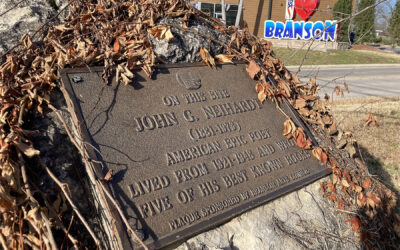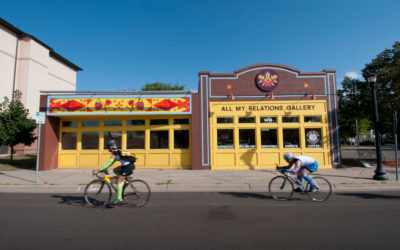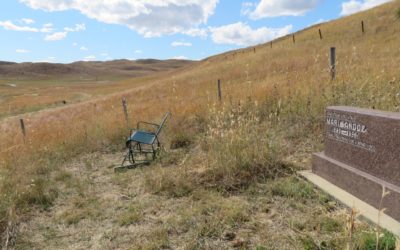This is the longer version of “Of Sunflowers, and Hope, in Times of Drought,” which first appeared in the Here section of Issue 14, printed July 2023.
It is late July 2021. I have driven my daughter an hour northwest to reach swathes of Minnesota sunflowers, the novelty of crowds of head-high plants taking our minds off the crowds of people we are still avoiding. We turn off the main road onto a rutted, grassy drive, where we pause more than once to watch small creamy butterflies dancing double helixes around each other. Once on foot, we can hear the fields before we can see the flowers. So many bees are feasting from the blooming yellow heads that the world has become a living hum. We make a contest of looking for the sunflower with the most bees on it at once (five). We marvel that there are not just bumblebees and honeybees, both of which we can identify, but also several otherbees, which we cannot. All going about their bee business, and each contributing one fizzing note to the chorus that vibrates on the wind.
Sunflowers reliably face east. As young plants, they shift their gaze over the course of a day to continue bathing their cheeks in direct light. But when they mature into impressive giants, their heads become too heavy to move. It feels vaguely sentient, their resolute turn to the rising sun. In an open prairie, all the other flowers appear lackadaisical by comparison.
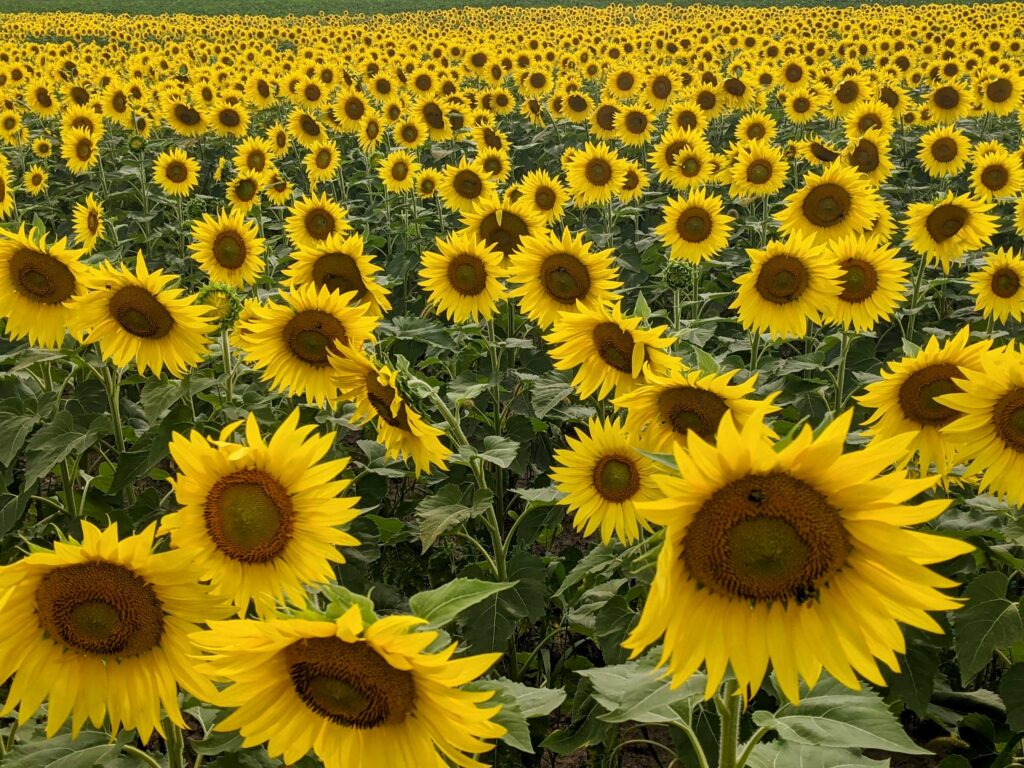
When arrayed in farmed rows that spread over acres, every flower stands at attention, saluting the sun. Soldier-like symmetry in plants is a little disquieting, especially from the back where the flowers’ heads wear huge, spikey green cups that look oddly like helmets. But viewed from the front, the illusion of a battalion disappears. Broad leaves dissolve rigid spacing. The flowers’ pebbled centers — in fact hundreds of tiny blossoms — are ringed by densely overlapping petals that splay outward until each edge is differentiated by the sun. Ray florets, they are called. Because what else would you name such golden magnificence? As the light filters through, every flower gets its own halo.
We have had so little rain this summer that at least one of these farm fields has been allowed to die back, presumably to preserve water for the others. Stunted stalks tilt in the dusty soil, sharp contrast to the adjacent field that thrums with insects. I find myself wondering what the untouched prairie looks like right now. Are its sunflowers wilting before they can bloom? Or do ones that seed themselves naturally have roots impervious to short-term drought, roots that press deeper to locate small bits of sustaining moisture? I assume uncultivated plants are more resourceful because they have not been coddled — although perhaps that is anthropomorphizing and wrong. Possibly their seeds simply remain dormant, nestled into today’s too-dry earth, quietly waiting for a rainier summer. That, too, is a kind of resourcefulness.
~ 🌻 ~
It always seems to be winter when I pick up Willa Cather’s My Antonia. Even so, the scene I cling to is not the one where the family digs tunnels through snowdrifts to get to the barn for chores. Instead, I find myself beguiled by the moment her protagonist reminisces over his first immersion into sunflowers. Newly-orphaned at the age of ten, Jim Burden is sent from Virginia to his grandparents’ farm in Nebraska in the 1890s, which, as an adult narrator, he recalls exploring:
Sometimes I followed the sunflower-bordered roads. Fuchs told me that the sunflowers were introduced into that country by the Mormons; that at the time of the persecution when they left Missouri and struck out into the wilderness to find a place where they could worship God in their own way, the members of the first exploring party, crossing the plains to Utah, scattered sunflower seeds as they went. The next summer, when the long trains of wagons came through with all the women and children, they had a sunflower trail to follow.
Cather’s novel is redolent with the wonder of this young boy, fresh from the Virginia woodlands, learning to understand the prairie’s splendid, wide-open skies and appreciate its promised freedom of movement. I love how his fascination with sunflowers as route markers casts them in the familiar mold of fairy tale: they function like a magical trail of breadcrumbs, perpetually renewing themselves to guide successive seasons of settlers safely west. Fuchs’s cherished story has an added ring of truth, tapping as it does into sunflowers’ power as a directional sign. It must have reassured countless drivers of horses and wagons across the plains that as long as they headed towards those sunny faces, they were moving in the right direction. Jim’s rhapsody takes a turn, though, to end here:
I believe that botanists do not confirm Jake’s story but insist that the sunflower was native to those plains. Nevertheless, that legend has stuck in my mind, and sunflower-bordered roads always seem to me the roads to freedom.
Despite the corrective that this is merely a legend, I find this last clause breath-taking. What a heady image — roads marked by towering flowers that proffer benediction over the movement of persecuted souls into a space where they could find religious freedom.
This passage mentions nothing of the people who were native to those plains. Of their relentless persecution. Of the incalculable damage those white settlers did in claiming land and displacing people and disrupting ecosystems and destroying long-established harmonies between humans and the earth. And yet, if read carefully, it admits to us that the flowers’ sanction of westward expansion is merely the stuff of legend, invented no doubt by white settlers. If read carefully, it might remind us that those roads were “bordered” by sunflowers because sunflowers were everywhere on those plains except where the roads, gashed through by wagons that scarred the land, prohibited the flowers’ growth.
How can we admire these breath-taking lines while doing justice to the truth that some people gained freedom by denying it to others? Where, in this complexity, does that leave the flowers? What is our relationship to the adulation and the promise, to the sheer joy of the beaming sunflower in its own right? Can we disentangle that from human history? Should we try?
~ 🌻 ~
May and June are normally rainy, plant-greening months in Minnesota. Grasses wake up. The monochrome of winter becomes variegated, lush. The state’s abundant water — 10,000 lakes! — is the stuff of legend, but it is also the winter snowpack, high water table, and abundant spring rains that makes Minnesota a promising location for the inevitable flood of climate refugees we know time will produce. Those living through years of devastating droughts to our west have periodically argued for the right to siphon off some Great Lakes’ water to slake their regions’ thirst. There are profound ironies in proposals to send natural resources west, as people contemplate fleeing east across North America seeking a more hospitable bit of earth.
But for the second summer in a row, Minnesota’s lot seems cast with the burning western half of the United States. In early July, grassy boulevards were simply tufts of brown. As I sit writing in August 2022, St. Paul, MN, is almost 7” below its normal year-to-date precipitation accumulation. Last year at this time it was even worse: some 80% of the state was marked Severe, Extreme, or Exceptional Drought.
My lilac hedge, some fifteen feet high and fifty feet long, droops. The soil is so dry, so deep, that any water you offer to flower gardens seeps far away from the roots before plants can slurp up enough to sustain themselves. Things I have never had to water — the rose that’s taller than my garage, for instance — are suffering. Small trees look pinched. Today I drove by several adolescent maples, not mere saplings, whose leaves were browning around the edges. Next year, they may be skeletons. If this landscape were a Dickens character, it would be described with a narrow face and pursed lips and a perpetually pained expression.
The perilousness of our situation feels ominous. A gossamer thread binds us together over our shared craving for water sources whose perpetuation we cannot command. I sense myself wilting too, these hot summer afternoons, under the weight of that concern.
~ 🌻 ~
By mid-August, none of us can recall accurately the last time it rained. One night, I dream that someone is outside throwing dried beans onto my roof. I awake in the dark, confused. Bags and bags and bags of beans clatter down, and I cannot figure out where they are coming from. Drowsily, I realize I am hearing the rattle of raindrops. I am nonetheless still baffled by the sound. When I wake up more fully, I register a deep sadness: it has taken just a few months to turn the sound of rain into a stranger.

Later that morning, I find myself holding my breath, afraid somehow to jinx the rain and make it stop if I celebrate too much. And yet I am ecstatic. I want to dance. It is raining. Not just a few half-hearted drops. But a persistent soaking that produces a smell lightly metallic and earthy — petrichor, it is beautifully named — a breeze wet with a wetness you can taste through an open window. It rains for hours before it clears. Miniature pools glisten on broad leaves in my garden, and I can breathe deeply once more.
The next night, it rains again, and I wake to a morning gloom that feels like celebration, a dawn overcast and damp. The heat has finally broken.
Out of town, driving through a downpour the following day, I get the giddy news from a friend: there has been a third night of rain! “Everything is saturated,” she writes. I do a little jig in my seat as I think of my trees, my roses, my enormous hedge, finally having their thirst quenched. I imagine them restored to a green as triumphant as the hills I am driving through: Wisconsin, the national map tells me, has experienced only Moderate Drought in one very tiny corner this year. I do not know how the drought knows where the state lines are.
~ 🌻 ~
I have quipped more than once, since moving to Minnesota, that I am grateful not to live in a sod house on the prairie when the winter winds come shrilling around the eaves and the snow mounts. But as I think about sunflowers and drought in this third summer of curtailed human connection, I find myself realizing how we are all tied to the land, even if we no longer live in shelters composed of it. We bear witness to the slow suffering of giant trees whose canopies become strangely translucent as leaves begin to shrivel. When rainless days extend to rainless weeks, we feel the tension in the air, the need palpable and parched, even if we do not consciously register it.
It only gives way when the rain comes, often in a powerful combination of disorientation and relief. I, too, was less wilted for a few days. The land was less gasping, the strain in people’s voices quieted itself a little.
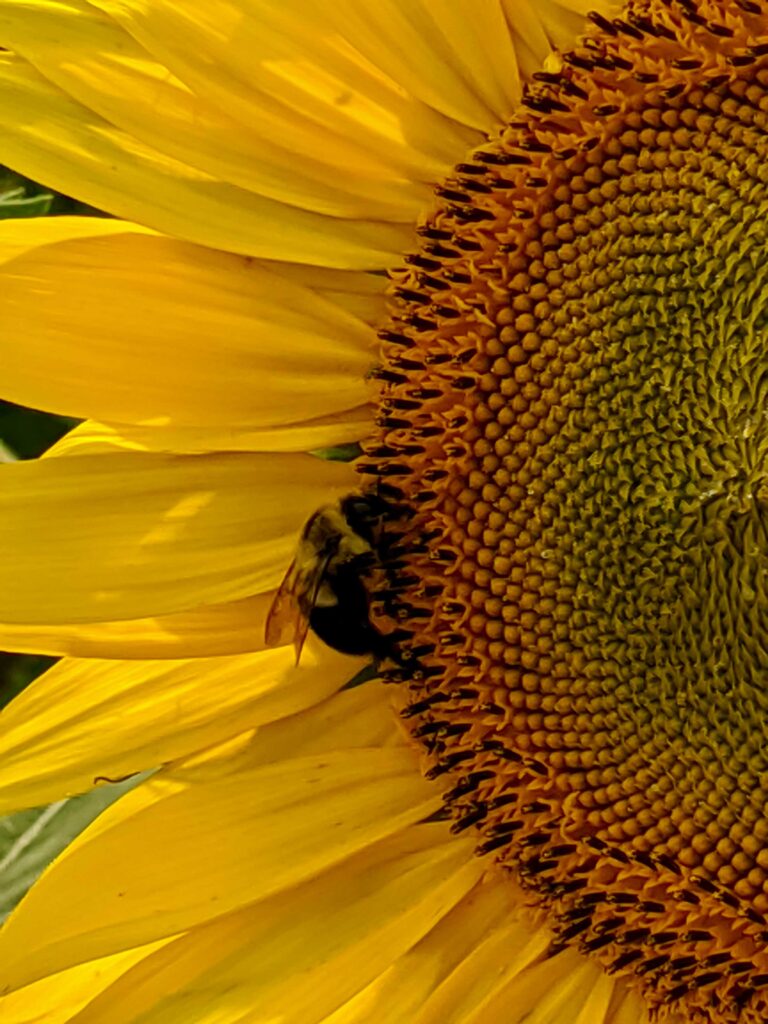
And so, sunflowers. Reminders of our earthly obligation to coexist. They serve as map and guide, as exuberant marker and sober memento. We cannot command the rain, but we can be more conscious of that collective feeling of reprieve carried on the damp wind. We must take practical steps to combat drought in our children’s lifetimes. We also should lean more fully into the things that connect us despite a burning world. Morning sun on our faces, the relief of rain. The bees, the sunflowers, the wonder of seeing it all for the first time through our daughters’ eyes.
Read this in print by ordering The New Territory Issue 14 or get a PDF copy.
